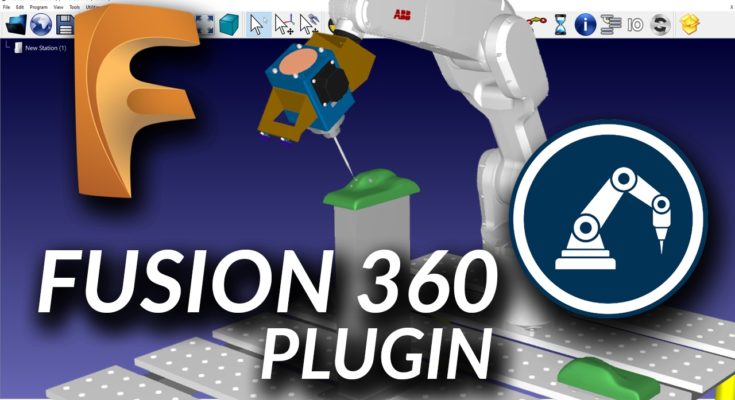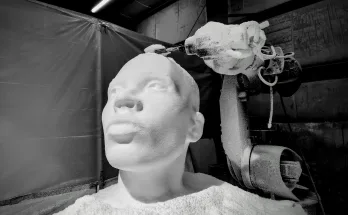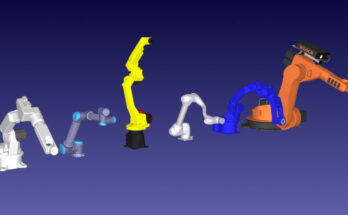Autodesk’s Fusion 360 looks set to be the future of computer-aided manufacturing. Our new RoboDK plug-in makes it easy to use this cloud-based CAD program with your robot.
The future of software, it seems, is in the cloud. Software companies in many industries are moving their packages into the cloud, giving a whole host of benefits for end users, including continuous updates and increased computing power.
Until now, Computer Aided Design (CAD) software has not yet broken into the cloud as much as the software has in other industries. But, the change is coming… and our new RoboDK plugin for Fusion 360 allows you to integrate your cloud-based CAD with any robot of your choosing.
Let’s have a look at the future of CAD and how RoboDK can work alongside it.
What is Fusion 360?
Fusion 360 is the new cloud-based CAD software from one of the leading software companies in the industry, Autodesk.
Autodesk is most famous for its programs AutoCAD and Inventor which have provided the backbone for many manufacturing businesses for the last three decades. Inventor (for which we also have a new plugin) was introduced in 1999 as a response to the popularity of SolidWorks and was specifically designed to make life easier for manufacturers.
Fusion 360 is the next step…
Eventually, Autodesk wants to move all of its software offerings to the cloud, according to the CAD Report. Fusion 360 is their way to do this and will eventually become the replacement for Inventor. However, there is some way to go before there is a completely cloud-based solution which all CAD users are happy with.
What’s Fusion 360 Good For?
Until Fusion 360 reaches the point when it can fully replace Inventor, the two software packages are best-suited to slightly different users.
Here are 5 of Fusion 360’s strengths compared to Inventor, and how they are relevant to RoboDK users:
1. New Users
Fusion 360 is very popular with makers, hobbyists and startups who are designing consumer products. It even has a free year-long license for early-stage startups and 3 years for students and educators. This is great for early-stage RoboDK users as we also have an educational version.
Inventor, on the other hand, is best suited to established large scale engineering or mechanical applications.
2. Mac Compatibility
Fusion 360 is great if you are exclusively a Mac user while Inventor is heavily tied into the Windows operating system.
RoboDK also supports Mac (as well as Linux and Android) so they make a great pairing.
3. Low Resource-Use
Fusion 360 is aimed at smaller projects than Inventor which means it’s less resource-hungry (using less RAM) and is better at getting things built fast.
RoboDK doesn’t require huge resources to run either, especially for smaller projects. However, like Inventor it is scalable and a more powerful computer will be able to handle larger, more complex projects.
4. Learning Curve
Fusion 360 is easier to learn than Inventor which means it’s great for newer CAD users.
RoboDK is also very easy to learn, especially if you follow our extensive library of tutorial videos.
5. Easy Project Sharing
As a cloud service it is very easy to share models with Fusion 360.
Although RoboDK is not cloud-based, it is also simple to share projects. Our robot project files have small file sizes and contain all information needed to run that project with no extra dependencies.
Conclusion
In summary, at present Fusion 360 is best suited to newer CAD users and small companies who want the flexibility of a cloud system. They want to get their designs up and running quickly without the steeper learning curve of Inventor.
Introducing… the New Fusion 360 Plugin
As with our other plugins (for Rhino, Mastercam, SolidWorks and Inventor) the main functionality of the plugin controlled by a standard set of buttons.
It includes the 5 standard buttons for CAD operations:
- Auto Setup — Select your geometries within Fusion 360 (curves, points, models) and they will be loaded into RoboDK along with the 3D model.
- Load Part — Sends the 3D model directly from Fusion 360 to RoboDK.
- Load Point(s) — Select a set of points and surfaces to create a new “point follow” program within RoboDK.
- Load Curve(s) — Select a set of curves and surfaces to create a RoboDK “curve follow” program.
- Settings — Customize the plugin by changing tolerances, scales and exported file type for 3D models. You can also define the names that objects will have when they appear in RoboDK.
As is also the case with the new Inventor plugin, there are two new buttons in this new plugin which make use of the CAM functionality in Fusion 360:
- Load NC Program — This loads the machining program from Fusion 360 into RoboDK. If you are using multiple machining tools, it will create a new program for each tool.
- Generate Robot Program — This allows you to generate the robot programs within RoboDK without ever needing to leave Fusion 360, which will speed up your workflow.
Is the Plug-In Right for You?
If you’re already using Fusion 360 then the new RoboDK plugin is a no-brainer. If you haven’t tried RoboDK yet, the plugin is a perfect excuse to give it a go! You can get a free demo version on the downloads page.
If you haven’t tried Fusion 360 yet, but you’re using RoboDK and you’re in the market for a new CAD program, now could be a great opportunity to try Fusion 360 out for yourself. It looks like the future of CAD is in the cloud, so the sooner you get on board the better prepared you will be!
How to Get Started Using the New Fusion 360 Add-In
The best way to test the new plugin’s capabilities is to try it out for yourself!
Download the latest version of RoboDK (if you haven’t already) and check out the documentation page, which explains all the functionality of the plugin in detail.
What do you think about cloud services? Tell us in the comments below or join the discussion on LinkedIn, Twitter, Facebook, Instagram or in the RoboDK Forum.




